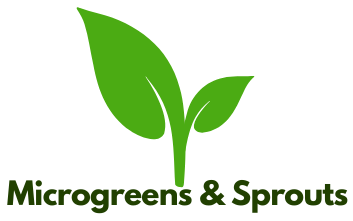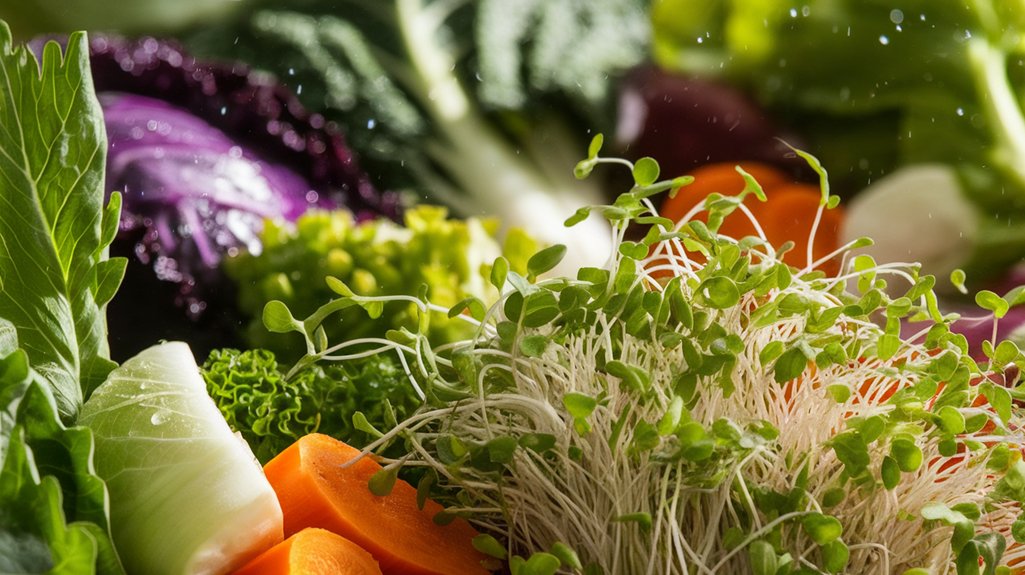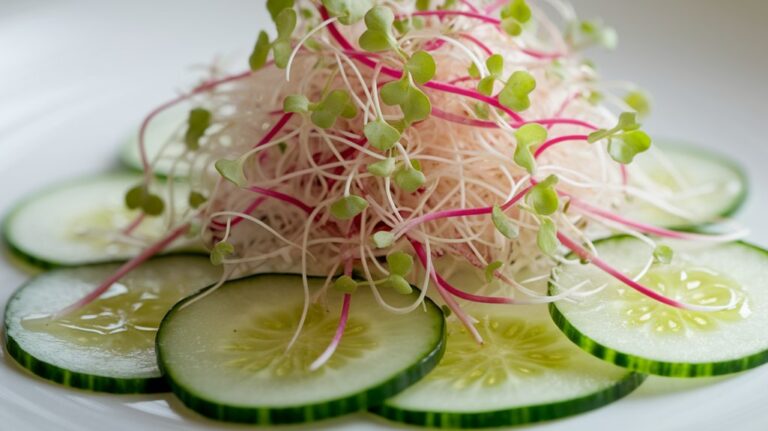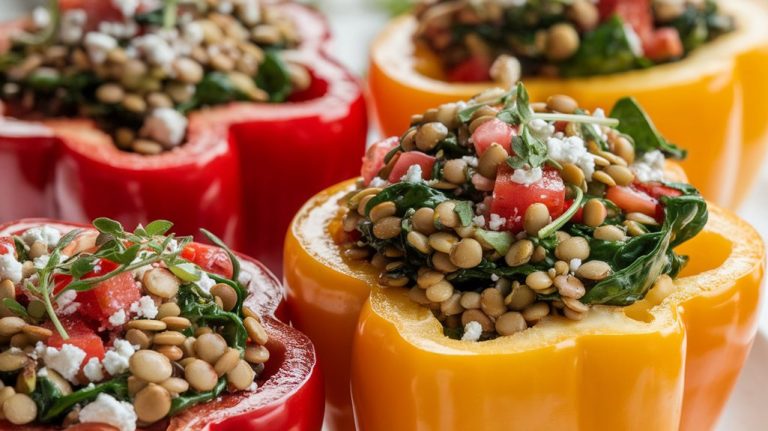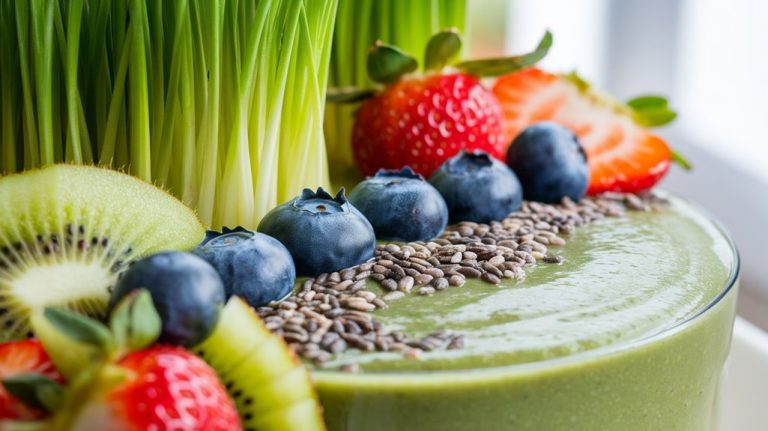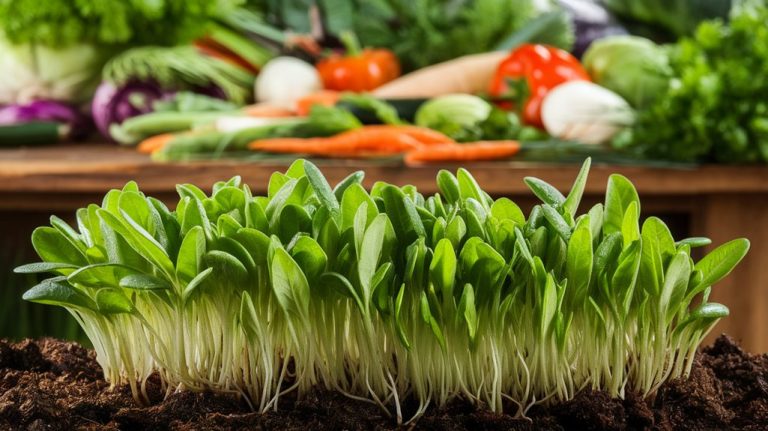Healthy Habits Start Here With Veggies & Sprouts
Incorporating veggies and sprouts into my meals is a game-changer for my health. They’re packed with essential vitamins, minerals, and antioxidants that boost my immune system and help prevent chronic diseases. I love spiralizing zucchini or roasting Brussels sprouts for a flavor-packed dish. Plus, sprouting unlocks even more nutrients, making them a superfood. By growing my own vegetables, I enjoy fresh produce and a rewarding hobby. There’s so much more to discover about healthy eating!
Key Takeaways
- Incorporating a variety of vegetables and sprouts into meals boosts nutrient intake and enhances overall health.
- Sprouts are nutrient-dense, providing higher vitamins and minerals than mature vegetables, supporting immune function.
- Creative cooking methods like roasting and blending make it easier to enjoy more veggies daily.
- Growing your own vegetables and sprouts allows for fresh, organic produce and fosters healthy eating habits.
- Regular vegetable consumption can lower the risk of chronic diseases and improve digestive health through fiber.
The Nutritional Benefits of Vegetables and Sprouts

When it comes to nutrition, vegetables and sprouts are real powerhouses. I’ve learned that they’re packed with vitamins, minerals, and antioxidants that help keep our bodies functioning optimally.
For instance, leafy greens like spinach are rich in iron and vitamin K, while cruciferous vegetables like broccoli boast compounds that support detoxification.
Sprouts, like alfalfa and broccoli sprouts, are especially nutrient-dense; they often contain higher levels of vitamins compared to their mature counterparts. Plus, they’re low in calories, making them great for weight management.
Eating a variety of these foods can enhance our immune system and reduce the risk of chronic diseases.
Creative Ways to Incorporate Veggies Into Your Meals
Incorporating more veggies into my meals has transformed my cooking and eating experience. I’ve found that adding vegetables doesn’t just boost nutrition; it enhances flavor and texture. Here are some creative ways I’ve started using veggies:
| Method | Veggies to Use | Dish Ideas |
|---|---|---|
| Spiralizing | Zucchini, Carrots | Noodle bowls, Salads |
| Roasting | Brussels Sprouts, Cauliflower | Side dishes, Toppings |
| Blending | Spinach, Kale | Smoothies, Soups |
These techniques make it easy to sneak in those essential nutrients. Whether it’s topping a pizza with roasted veggies or blending spinach into my morning smoothie, I’ve discovered that incorporating veggies can be both fun and delicious!
The Science Behind Sprouts and Their Health Impact
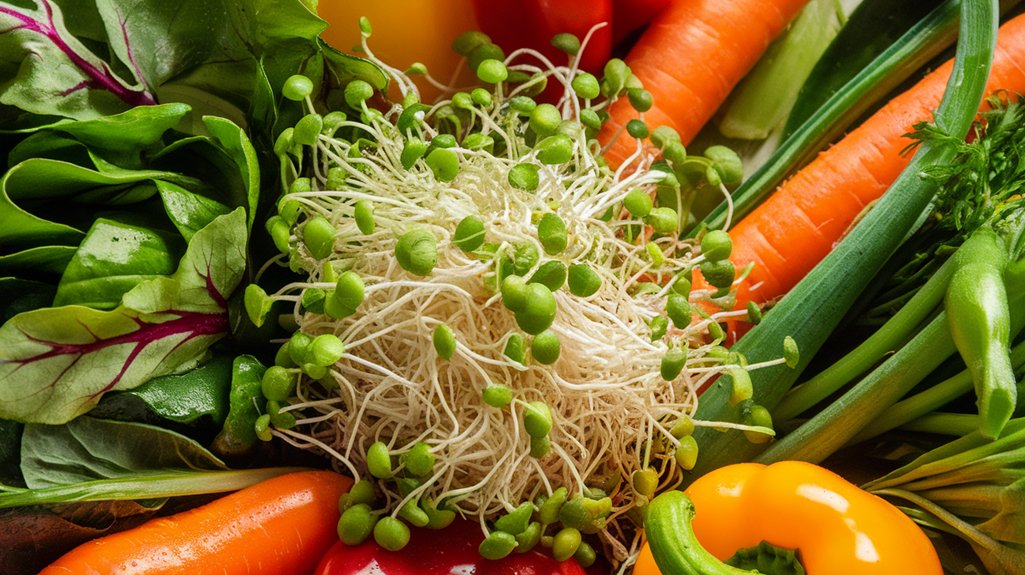
Although I’ve enjoyed using a variety of vegetables in my meals, I’ve recently become fascinated by the science behind sprouts and their impressive health benefits.
Sprouts, like alfalfa and broccoli, undergo a germination process that unlocks nutrients, making them more bioavailable. Studies show they’re rich in vitamins, minerals, and antioxidants, which can boost our immune system and reduce inflammation.
Interestingly, they also contain enzymes that aid digestion, helping our bodies process other foods more efficiently. Plus, the fiber in sprouts supports gut health.
Adding these tiny powerhouses to my diet hasn’t only diversified my meals but also enhanced my overall health. It’s amazing how something so simple can have such a profound impact on wellness!
Easy Recipes to Boost Your Daily Veggie Intake
To effortlessly increase my daily veggie intake, I’ve discovered that simple recipes can make all the difference. Here are a few easy ideas to pack more nutrients into my meals:
| Recipe | Ingredients | Instructions |
|---|---|---|
| Veggie Stir-Fry | Broccoli, bell peppers, carrots | Sauté in olive oil, add soy sauce. |
| Green Smoothie | Spinach, banana, almond milk | Blend until smooth. |
| Roasted Veggies | Zucchini, sweet potatoes, herbs | Toss with olive oil, roast at 400°F for 30 mins. |
| Veggie Omelette | Eggs, spinach, tomatoes | Whisk and cook in a skillet. |
| Salad Bowl | Mixed greens, cucumbers, chickpeas | Toss together, drizzle with dressing. |
These recipes not only boost my veggie intake but also keep my meals exciting and flavorful!
Tips for Growing Your Own Vegetables and Sprouts at Home

Growing my own vegetables and sprouts at home has been a rewarding journey that not only enhances my meals but also connects me to the food I eat.
To start, choose a sunny spot in your garden or on a windowsill for containers. I’ve found that using organic seeds makes a significant difference in taste and nutrition.
For sprouts, a simple jar and some water are all you need; just rinse them daily. Ensure your soil is well-draining and rich in nutrients; I often mix in compost for added benefits.
Regular watering is crucial, but don’t overdo it! Lastly, be patient—watching them grow is part of the joy.
With these tips, you’ll enjoy fresh, delicious veggies and sprouts in no time.
Frequently Asked Questions
How Can I Get My Kids to Eat More Veggies?
Getting my kids to eat more veggies can be a challenge, but I’ve found a few effective strategies.
I involve them in meal prep, letting them choose and wash vegetables, which sparks their interest. I also make veggies fun by creating colorful plates or trying new recipes together.
Plus, I lead by example—when they see me enjoying veggies, they’re more likely to give them a try. Consistency and creativity truly help!
Are There Any Vegetable-Based Snacks That Are Healthy?
Absolutely, there are plenty of healthy vegetable-based snacks!
I love snacking on carrot sticks with hummus or cucumber slices topped with a sprinkle of sea salt.
Roasted chickpeas are another favorite; they’re crunchy and so satisfying.
You can also try making kale chips—just toss them in olive oil and bake until crispy.
These snacks not only taste great, but they also pack in nutrients and keep me feeling full between meals.
What Are the Best Storage Methods for Fresh Vegetables?
When it comes to storing fresh vegetables, I’ve found a few effective methods.
First, I wrap leafy greens in damp paper towels and place them in a breathable bag to keep them crisp.
For root veggies, I store them in a cool, dark place, like a pantry.
I also use airtight containers for cut veggies in the fridge to maintain freshness.
These simple techniques help my produce last longer and stay nutritious!
Can I Freeze Sprouts for Later Use?
Yes, you can freeze sprouts for later use! I’ve done it myself, and it’s a great way to preserve their freshness.
First, I blanch the sprouts in boiling water for a couple of minutes, then immediately transfer them to ice water to stop the cooking process.
Once they’re cool, I drain and pack them into freezer bags. They keep well for a few months, making it easy to add them to meals later on!
How Do I Know if a Vegetable Is Organic?
When I’m trying to determine if a vegetable is organic, I look for a few key indicators.
First, I check for a label or sticker that says “USDA Organic.” I also pay attention to the price; organic veggies tend to be a bit more expensive.
Finally, I often ask local farmers at markets about their growing practices. If they can confidently explain their methods, I’m more likely to trust their produce as organic.
Conclusion
Incorporating more veggies and sprouts into my diet has transformed my health and well-being. Their nutritional benefits are undeniable, and with so many creative ways to enjoy them, it’s easier than ever to make them a staple in my meals. Plus, growing my own adds an extra layer of satisfaction. I encourage you to embrace these habits too—your body will thank you, and you’ll discover a world of flavors and textures that nourish and delight!
